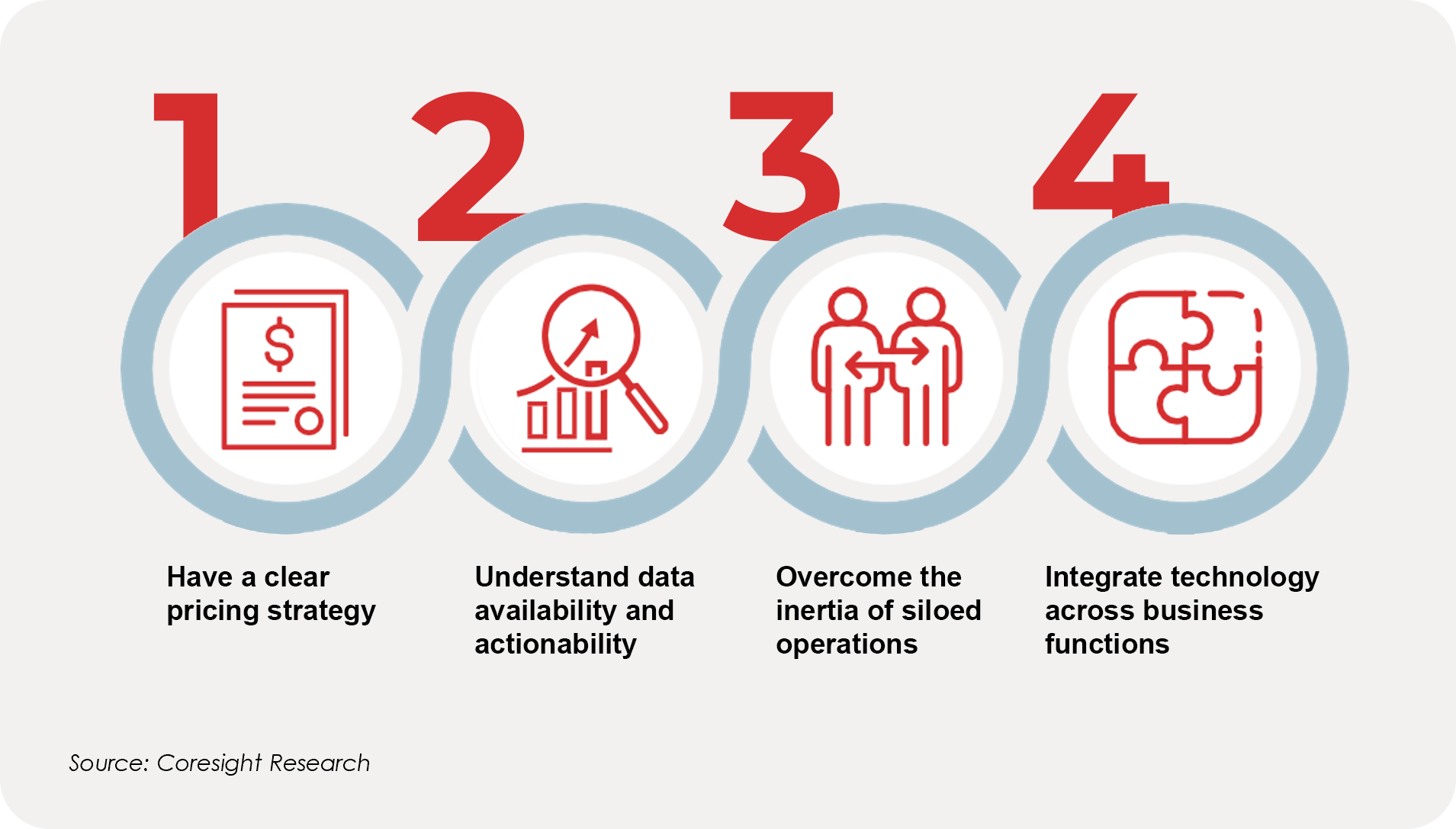Retail pricing precision: AI-driven solutions for 2024 and beyond
Apr 11, 2024 • 5 min
Precision in price planning and setting is critical to attracting and retaining customers while maintaining profitability. We partnered with Coresight Research to produce a report, Precision Pricing in Retail: AI-Driven Pricing Decisions for 2024 and Beyond, that explores the challenges in price setting and discusses how retailers can take a stable and robust approach to pricing strategies to win customers and sales.
Key takeaways from the report include:
- Growing economic volatility continues to strain decision-making.
- Integrated business functions are essential for making informed pricing decisions.
- AI can help alleviate key pricing challenges, such as a lack of flexibility in rule-based pricing and inaccurate inventory planning.
- Clarity in strategy, integrated data, and interconnected functions can support technology implementation.
Growing macroeconomic and geopolitical volatility heightens pricing challenges
The last four years have been fraught with a seemingly endless stream of events that have driven global economic volatility. Geopolitical tensions and stressed supply chains have impacted the entire retail, wholesale, and consumer goods industry.
Perceived product value, household incomes, and consumer confidence are all key drivers of demand and preference. As these preferences shift in the wake of economic uncertainty and supply disruptions, pricing becomes increasingly tricky. Further, rising production costs create pressure from input prices, making optimal product pricing even more challenging. When pricing their products, retailers must consider everything from the consumer and supply sides.
A proactive approach to pricing is critical to addressing uncertain supply or demand situations and responding to increasing costs to maintain profitability. Dynamic pricing would also enable retailers to quickly pass on savings to their customers in an easing environment to retain a positive brand image. That level of dynamic pricing can only be achieved by leveraging advanced technologies such as artificial intelligence.
Pricing is a complex and connected business function
An optimal pricing strategy involves multiple functions, including analysis of external factors (such as competitor prices) and tracking inventory in real-time to understand the stock turnover rate. The interconnectedness of merchandising functions means that effective price planning and setting rely heavily on accurate demand forecasting, informed by customer sentiment and sales data.

Taking demand variations across sales channels and store locations into account is imperative, though challenging, for price planning: misunderstood demand variations can lead to unsold inventory or product shortages, which retailers would have to address through price setting and promotional activity; effective demand forecasting and allocation planning would enable retailers to set optimal prices to maximize sales and margins.
AI alleviates challenges in achieving precision in price planning
To overcome the multiple challenges that arise across merchandising functions, brands and retailers can leverage AI. AI-enabled solutions allow retailers to quickly analyze vast amounts of data and gain a comprehensive understanding of shifts in shopper preferences and demand patterns.
Let’s look at three primary challenges that AI and machine learning can help address:
- Limited flexibility in rule-based pricing: Strategies built on multiple dependent variables, such as competitor pricing, seasonality, and promotions, have a higher likelihood of yielding strong top-line improvement. AI-based pricing software that offers scenario testing capabilities and visibility across business functions can further increase strategic effectiveness.
- Inaccurate inventory planning: Overstocking or understocking leads to unplanned markdowns or unwanted price hikes. AI-driven forecasting helps retailers better understand consumer demand across channels and stores, enabling them to improve product availability and implement a more robust overall pricing strategy.
- Increasing costs: Volatility in input costs such as labor, raw materials, and shipping directly impacts margins. AI-based pricing software facilitates dynamic real-time product pricing adjustments to adapt to rising costs and maintain profitability.
Having a structured approach is critical to AI-based pricing
AI-based pricing software can help retailers manage end-to-end pricing throughout the product lifecycle to remain competitive, and the need for it is heightened amid demand volatility and rising input costs.
The report outlines four steps to effectively incorporating an AI-based pricing solution:
- Have a clear pricing strategy: Retailers must have a clear understanding of each stage of decision-making, such as data analysis, consumer segmentation, and competitor price analysis, as well as how technology deployment will impact each of them and align with their business strategies.
- Understand data availability and actionability: It is pivotal for retailers to understand the quantity, quality, and granularity of the shopper data to which they have access. Actionability is critical when using AI-based tools—for example, grouping products with different elasticities or ignoring the impact of seasonality can lead to drawing ineffective insights.
- Overcome the inertia of siloed operations: While advanced pricing solutions understand the importance of interconnected businesses, retailers have long-standing inertia of siloed operations. Retailers need to understand that for any technology to yield returns, interdependent functions cannot operate in silos.
- Integrate technology across business functions: As pricing is highly interconnected with various merchandising functions, investing in technology that can be integrated company-wide and scaled to meet business needs is essential. Business decisions should be made based on a continuous real-time feedback loop across business functions.

Gaining advantage: The benefits of dynamic, AI-based pricing
Shifting from reactive and static rule-based forecast pricing to AI-based dynamic pricing has multiple underlying benefits for retailers, including:
- Higher revenues and improved margins: Pricing products and making real-time changes based on demand, seasonality, and product elasticity allows for timely promotions and helps avoid unwanted markdowns, which translates to revenue and margin improvement.
- Improved loyalty: AI-based pricing software can help retailers keep pricing consistent with their brand image while offering personalized prices through scenario simulations that help evaluate shoppers’ responses to price changes, driving loyalty and translating to repeat purchases.
- Efficient markdowns and promotions: AI-based pricing allows retailers to unify promotional calendars and pricing strategy, giving promotional teams a strategic understanding of price setting and allowing for consistent promotions across channels and stores.
The Coresight Research report offers a blueprint for mastering the art of pricing to secure customer loyalty and drive sales
In an era where attracting and retaining customers while safeguarding profitability is paramount, achieving precision in price planning and setting emerges as a crucial competitive advantage. Learn more in the full report.



